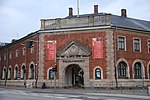Stephen Hansen Mansion
1764 establishments in DenmarkHouses completed in 1764Listed buildings and structures in Helsingør MunicipalityRococo architecture in Denmark

The Stephan Hansen Mansion (Danish: Stephen Hansens Palæ) is a listed town mansion overlooking Wibroes Plads and the Øresund in Helsingør, Denmark. It was built by Philip de Lange and represents the transition from Baroque to Rococo architecture.
Excerpt from the Wikipedia article Stephen Hansen Mansion (License: CC BY-SA 3.0, Authors, Images).Stephen Hansen Mansion
Strandgade, Helsingør Municipality
Geographical coordinates (GPS) Address Nearby Places Show on map
Geographical coordinates (GPS)
| Latitude | Longitude |
|---|---|
| N 56.035 ° | E 12.615547222222 ° |
Address
Strandgade 95
3000 Helsingør Municipality
Capital Region of Denmark, Denmark
Open on Google Maps










